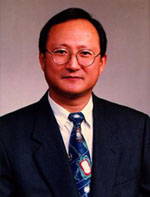Jang-Ok Cho '90
 Jang-Ok Cho was born on July 20, 1952 in Moo-An, Korea. He attended Sogang University and received a BA degree in 1982 and MA degree in economics in 1984. He came to the University of Rochester in 1985 and wrote his thesis "Essays on the Business Cycles" under the supervision of Professors Thomas F. Cooley and Richard Rogerson. Then, he joined the Queens University in Canada as an assistant professor.
Jang-Ok Cho was born on July 20, 1952 in Moo-An, Korea. He attended Sogang University and received a BA degree in 1982 and MA degree in economics in 1984. He came to the University of Rochester in 1985 and wrote his thesis "Essays on the Business Cycles" under the supervision of Professors Thomas F. Cooley and Richard Rogerson. Then, he joined the Queens University in Canada as an assistant professor.
His primary research focuses on explaining business cycle fluctuations. Many of his publications are widely read and cited. Three notable ones are:
"The Business Cycle with Nominal Contracts," (with Thomas F. Cooley) Economic Theory, 1995.
Ever since John Maynard Keynes wrote The General Theory of Employment, Interest and Money economists have wondered how inflexibility in nominal wages affects business cycle fluctuations. Wage inflexibility may arise due to wage contracts. Jang-Ok shows that only a very small amount of rigidity is necessary to cause output volatility of the magnitude observed in the US economy. With nominal wage contracts, the volatility induced by monetary policy and shocks to economy increases sharply with contract length. But the economy with nominal contracts is not consistent with US data in several respects, such as volatility and persistence in hours and output.
"Cyclical Factor Utilization," (with Mark J. Bils) Journal of Monetary Economics, 1994.
What determines how intensively factories are used (say 8 or 24 hours a day) or how hard workers labor on the job? In this paper Jang-Ok models the optimal utilization of capital and labor. Plausible variations in capital and labor utilization help to explain the observed magnitude of US business cycle fluctuations. Macroeconomists are also very interested in the lead and lag relationship between certain variables over the business cycle. Allowing for a variable rate of factor utilization creates very interesting and realistic lead and lag relationships: employment does not peak until a full quarter after output; workweeks, effort, capital utilization, and productivity all sharply lead the business cycle.
"Family Labor Supply and Aggregate Fluctuations," (with Richard Rogerson) Journal of Monetary Economics, 1988.
One of the big puzzles in macroeconomics has been the fact that aggregate hours vary greatly over the business cycle without much variation in wages. The standard equilibrium approach to business cycles requires a very elastic labor supply to explain this stylized fact. Jang-Ok shows that in an economy populated by families consisting of males and females, workers can display, quite naturally, very elastic labor supplies. In addition, the resulting cross-sectional heterogeneity leads to interesting forms of aggregation bias, which help to resolve the hour-wage puzzle.
Before pursuing a career as an economist, Jang-Ok wrote poems and short novels. He also enjoys climbing mountains.
Yongsung Chang (August 7th, 1998)Jang-Ok Cho is currently an associate professor at Sogang University in Seoul, Korea.
